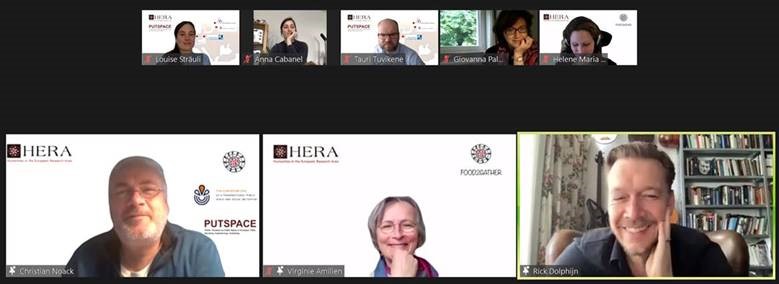Tuesday, May 11, researchers from F2G discussed public space during social distancing, with two other HERA projects; PUTSPACE and SPAS. This was the third in a series of webinars by HERA.
“Rethinking public spaces in times of social distancing” was organized by three HERAnet projects: PUTSPACE, SPAS and FOOD2GATHER. A presentation of the webinar can be found here.
The program started with short introductions of each Hera project, before the keynote speakers were given the screen. First off was Laurent Thévenot, from École des Hautes Etudes en Sciences Sociales, who developed the pragmatic sociology. His presentation focused on the tensions of personal closeness and public distancing, as well as grammars of commonalities and difference. Reminding the three different regimes of engagement (personal, planned action and justification) and underlined the different ways of making public building on constraints linked to personal engagement. Using concrete examples linked to the three HERAnet projects he underlined the importance of bodily practices within transport, food and spas’ contexts and how social distancing is then opposite to social closeness.
The next keynote, F2G’s Rick Dolphijn, Utrecht University, talked about the notion of public space as a European concept. He gave an historical overview of the construction of the Agora in ancient Greece, and explained how the idea of a public space linked to the Agora emerged after fighting off tyranny, but before the state. As such, the Agora is a place that is both civilized and uncivilized, where power is questioned, and where inclusion and otherness mingle. Nowadays, it can be found anywhere where we meet, whether it is in parks or on internet forum -making the web an international Agora?
Next, the three projects presented some reflections on how they perceived that social distancing affected public space, seen through the lens of their own subjects, that is to say food, public transportation and spas. All presentations were done by PhD or Post-doc candidates; Helene Fiane Teigen from F2G, Louise Sträuli from PUTSPACE, and Anna Cabanel from SPAS. In addition to the PhD candidates, the panel further included project leaders Christian Noack (SPAS), Tauri Tuvikene (PUTSPACE) and Virginie Amilien (F2G), as well as Giovanna Palutan, post doc from F2G – to bring a more nuanced perspective from our project as the research takes place in six different countries and their experiences with public space and social distancing varies.
The following discussion touched upon many interesting aspects of public space and social distance, such as focus on labour, hybridity, hospitality and making visual aspects that were there before but didn’t appear. We all agree about the strong impact of the covid 19 on public space , as well as the prominent role of digitalization in adaptation or changes. Moreover the social class dimension was underlined at several levels, both for emphasizing the difficulties to adapt for people without stable material support (it could be a home, an electronic device or a car) and to underline the visible change in leisure activities in public space (reminding about the first HERAnet webinar series, “Pleasure in Crisis? Resilience of publicentertainment and festivity in the past and present” which took place on 16 th March.)

This is just a short overview of the 1,5 hour seminar which proved to be a very interesting seminar, where reflections on publicness, space and social distancing emerged and discussed.
